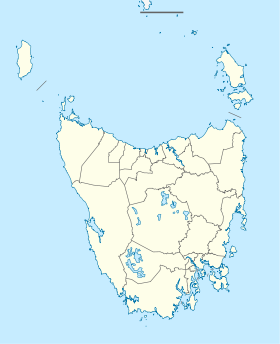Oyster Cove
| Oyster Cove | |||||||
|---|---|---|---|---|---|---|---|
|
|||||||
|
|||||||
|
|||||||
|
|||||||
|
|
|||||||
Oyster Cove (German: Austernbucht ) was a settlement for convicts near the Tasmanian capital Hobart . It was built in 1843 and used until 1847. In the years 1843 to 1876 the last remaining Aborigines of Tasmania were housed there. It was the last residence of this subsequently extinct indigenous population of Tasmania. Today only descendants who emerged from connections with Europeans are still alive.
settlement
The buildings were made of wood and had foundations in a wetland, so they soon began to rot and the site was swept by cold winds from the south. The settlement was first occupied by female and later by male convicts.
In 1847 47 surviving Tasmanians from Wybalenna (five boys and five girls, 23 women and 14 men) were to be accommodated there, with only 44 reaching this place. The buildings had been freshly painted, equipped with tables, beds, chairs and glass windows, and they were warmly received by the settlers around the place. The houses were grouped and the married lived on one side and the unmarried lived on the other side of this settlement. Eight of the incoming children over the age of 10 did not live in the Oyster Cove settlement but were placed in a school in Hobart.
The people in charge inspected the place and the food was better than in Wybalenna , but the living conditions in and around the buildings were unhealthy due to the moisture and cold wind. The Aborigines took advantage of their freedom, went hunting, fishing, building their own huts and growing food. Five of the Tasmanians left to hunt whales, and by 1851 another 13 had gone, and by 1859 there were only twelve people in the settlement. In 1869 there was only Truganini , the last Tasmanian woman there. In 1874 the site was flooded and the buildings abandoned and Truganini left the site for Hobart two years before her death in 1874, where she lived with Mrs. Dandridge, the former wife of the superintendent .
today
Oyster Cove is now an Aboriginal place. In 1981 the government of Tasmania declared 0.0303 square kilometers of the Oyster Cove settlement a historically protected site and since 1984 the Tasmanian Aboriginal Center has been claiming land rights on Oyster Cove. In 1995, 0.01 square kilometers of the 3.8 square kilometers of land in the entire Oyster Cove was given to the Aboriginal Center.
The Tasmanian Aboriginal Center hosts the Oyster Cove Festival each year with music, food and performances. The Tasmanians use this place to maintain their traditional culture and spirituality of their tribe and country.
Web links
Individual evidence
- ↑ Australian Bureau of Statistics : Oyster Cove ( English ) In: 2016 Census QuickStats . June 27, 2017. Retrieved April 3, 2020.
- ↑ a b c d Information on www.utas.edu.au accessed on June 18, 2009 (there are slightly different figures in other sources)
- ↑ Information from www.andaman.org ( Memento of the original from October 24, 2009 in the Internet Archive ) Info: The archive link was inserted automatically and has not yet been checked. Please check the original and archive link according to the instructions and then remove this notice. , accessed July 18, 2009


